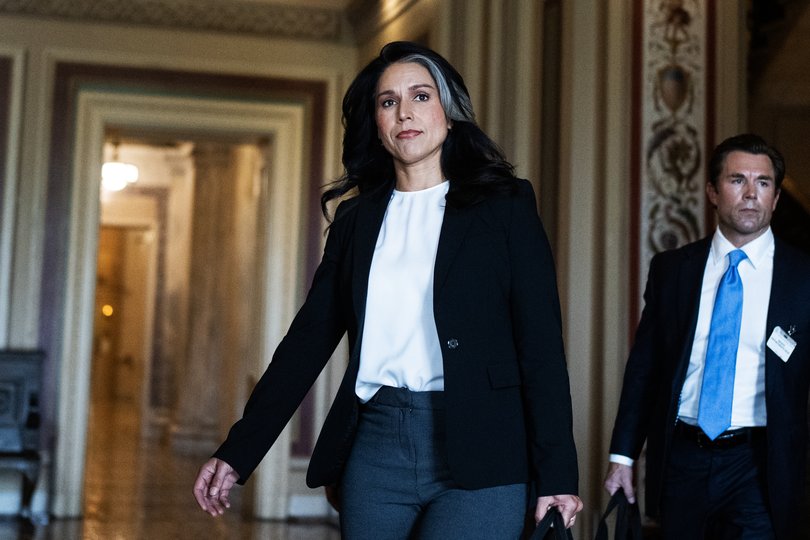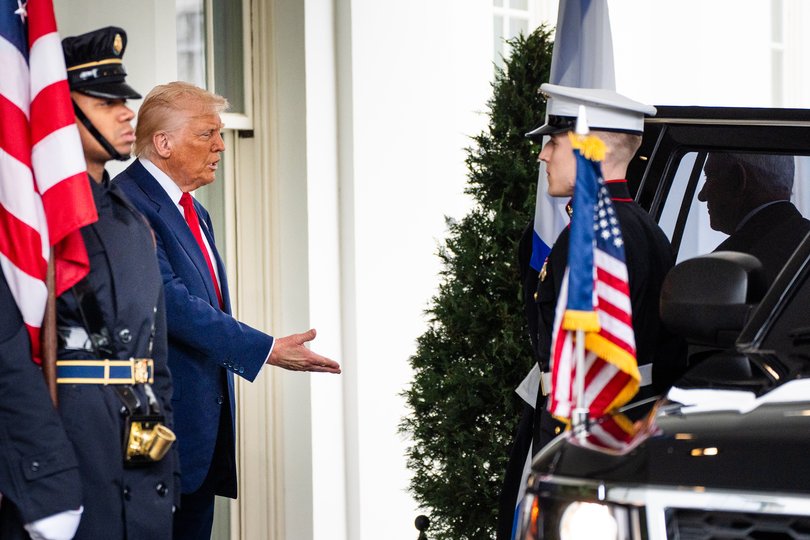Benjamin Netanyahu decided on Iran war last year, then sought to recruit Donald Trump

In the fall, long before US President Donald Trump embarked on an effort to resolve concerns over Iran’s nuclear program through negotiations, Prime Minister Benjamin Netanyahu had already set Israel on the road to war, according to current and former Israeli officials.
After Israel decimated Iran’s air defenses in a missile skirmish and crippled its main ally, Hezbollah, in October, Mr Netanyahu issued a general order to prepare for a strike, the current and former officials said.
Israeli intelligence officials began huddling to compile lists of dozens of Iranian nuclear scientists and military leaders who could be targeted for assassination.
Sign up to The Nightly's newsletters.
Get the first look at the digital newspaper, curated daily stories and breaking headlines delivered to your inbox.
By continuing you agree to our Terms and Privacy Policy.Israel’s air force began to systematically take out air defenses in Lebanon, Syria and Iraq to clear the skies for future bombing runs against Iran.
Meanwhile, Israeli officials were pursuing another track in their preparations — to sway Washington. Israeli officials have long believed that military action with US participation to target the Iranian nuclear program would be more effective than Israel going alone.
On Saturday, Mr Trump indeed joined the conflict, ordering US forces, including B-2 strategic bombers, to strike three Iranian nuclear sites.
Throughout the fall, the Israelis had met with their Biden administration counterparts to discuss intelligence collected by both countries in the summer that showed Iranian nuclear scientists were gathering to resume theoretical research on weaponisation, according to three people with knowledge of the matter.
But US intelligence analysts did not conclude that the Iranian leadership had made such a decision - an assessment US spy agencies revisited and maintained throughout the spring under the new Trump administration and up until the time Israel launched strikes, said five people familiar with the conclusions.
In private conversations, however, senior Israeli government officials said they had already decided by March, weeks before Mr Netanyahu met Mr Trump in the Oval Office on April 7, to strike Iran with or without US participation by June at the latest, said two people with knowledge of the matter. The reasoning was that Iran would have rebuilt its air defenses by the latter half of the year, one of the people said.
Ultimately, when Mr Netanyahu finally launched his surprise attack on Iran in the early hours of June 13 while Mr Trump’s negotiations were still underway, the decision was not so much driven by new intelligence indicating an Iranian sprint for a nuclear weapon or any imminent threat to Israel.

Rather, Israel seized on what it saw as a unique opportunity to execute plans, carefully laid months and years in advance, to heavily damage a weakened Iran that had long waged a bloody proxy conflict with Israel and to set back Iranian nuclear and missile programs, Israeli and US officials and advisers to both governments say.
Whether or not Mr Netanyahu had enough evidence of Iranian progress toward a nuclear weapon to justify an attack has been the subject of intense debate globally and raises questions about the strike’s permissibility under international law.
In recent days, the issue has appeared to generate friction inside the US administration, with Mr Trump repeatedly dismissing the assessment delivered in March by Director of National Intelligence Tulsi Gabbard that Iran’s leadership has not ordered the development of a nuclear weapon and telling reporters he personally believed that Iran was “very close” to a bomb.
Mr Netanyahu, who has argued for decades that Iran was on the verge of acquiring nuclear weapons and should be halted by military strikes, has acknowledged in recent interviews that Iran was still months or a year away from a weapon.

What was undisputed, he has said, was that Iran had enriched large amounts of uranium to a level well beyond what is required for civilian use and built up a dangerous arsenal of ballistic missiles.
Israel’s calculus for attacking Iran was driven by a sense of both opportunity and necessity, said an Israeli official who, like many others quoted in this article, spoke on the condition of anonymity to discuss internal deliberations.
“It is true there was no better time: Israelis have never been more well-practised, and Iran and their proxies have never been weaker,” said the Israeli official.
“But that’s not enough for us to operate. The reason we operated is necessity and understanding there is no alternative. What if they break out (toward a nuclear weapon) and there is no way for us to notice? There is no safety zone left.”
US intelligence agencies beginning late last year picked up on Israeli preparations for war and warned Washington policymakers that Israel was likely to strike in the first six months of 2025.
But Mr Netanyahu’s plan was unexpectedly delayed when he was summoned to Washington to meet Trump and told that the United States would enter direct negotiations with Iran to solve the problem diplomatically.
The PM’s strong inclination to strike, however, remained unchanged, said a person with knowledge of the thinking of top Israeli officials.

Going into the spring, there was also concern among Israeli officials that any potential deal between Trump envoy Steve Witkoff and Iran would still allow Iran to eventually possess a bomb, an Israeli official added.
And, a former senior Israeli official said, the Israelis had been anticipating the scheduled retirement of General Michael E Kurilla, the US Central Command chief who had helped make war plans with Israel throughout the spring.
In an interview Tuesday with pro-government Channel 14 television, Mr Netanyahu said he had decided on the exact timing of the strike only two weeks earlier, but that he had made the “difficult” decision to carry out the operation “several months ago” and began fleshing out the plan and its element of surprise in April.
The key was to eliminate the nuclear experts, Mr Netanyahu said: “Those were my instructions: We’re going after the scientists, take them out.”
In Israel, the majority of the security establishment and political parties have supported Netanyahu’s decision to execute what they consider a preventative strike.
For decades, a bedrock of Israeli strategic thinking has been the “Begin Doctrine,” named after former prime minister Menachem Begin, who defended Israel’s 1981 bombing of the Osirak nuclear reactor in Iraq as “anticipatory self-defense” against a potential enemy making a weapon of mass destruction.
But a minority of those have questioned the wisdom of carrying out a surprise attack while Mr Trump was still pursuing the diplomatic route - and, they say, without proof that the Iranians had decided to construct a nuclear weapon.
“We should have given the political route a chance,” said Danny Citrinowicz, a former head of the Iran desk in the research department of Israeli military intelligence.
“Now, we got operational achievements but the risks are enormous. We’ve never fought with a country like Iran. We find ourselves not knowing where the (highly enriched uranium) or centrifuges are. If we had an agreement, we would at least have less unknowns.”
Since Mr Trump pulled out of the Obama-era nuclear deal with Iran in 2018, Iran has sharply increased its stockpile of near-weapons-grade enriched uranium, according to the International Atomic Energy Agency.
But intelligence agencies have debated whether Iran has resumed its effort to build a weapon — known as Project Amad — that was halted by Ayatollah Ali Khamenei, Iran’s supreme leader, in 2003.
Last year, US intelligence officials, including CIA Director William J Burns, reviewed new intelligence and concluded that Iranian scientists were revisiting previously suspended nuclear weapons research, exploring paths that could allow them to more quickly make the leap to a crude nuclear bomb — if Khamenei so chose, three people familiar with the matter said. Israeli officials then came to the same realization.
But US intelligence officials did not conclude that Khamenei had changed his stance and sanctioned a bomb, said former US and Israeli officials with knowledge of the matter.
“We knew they could speed up their timeline if they decided to change course,” a former senior US official said.
The Israelis were more alarmed.
The “main difference” between US and Israeli views “was tactical and not substantial,” said a senior Israeli official. “We did see that Iran was advancing with a project,” the Israeli official added. “It wasn’t like (Iran) had a timeline, but the route that they had chosen was very concerning and dangerous. And some of the experts here had huge concerns.”
Jacob Nagel, a longtime adviser to Mr Netanyahu on Iranian nuclear issues and a senior fellow at the Foundation for Defense of Democracies, said Iranian scientists were working in academic settings, and there was never a “smoking gun” showing they had broken new ground on aspects of weaponisation that were prohibited under the 2015 nuclear agreement, such as a multi-point detonation device used to trigger a nuclear explosion.
But they were conducting research seemingly surreptitiously on topics that were difficult to justify as having only civilian applications, Mr Nagel said. He added that Khamenei “probably knew what they were doing.”
At one point, the Biden administration asked Iran about the scientists’ activities, but the scientists carried on, which further fueled Israeli suspicions going into the spring, Nagel and another Israeli official said.
As Israeli officials geared up in recent months to strike while hoping the US would join, Israel made another push with the Trump administration as part of regular intelligence sharing.
US intelligence officials did not see anything startlingly new, according to two people with knowledge of the matter.
But Israeli officials believed intelligence showed the scientists were revisiting studies in several alarming areas, including the multi-point detonation device, the production of plastic explosives and experiments on neutron radiation, according to one person who was briefed by Israeli officials in recent weeks.
Israeli officials acknowledged that they still assessed Khamenei had not ordered the production of a nuclear weapon, the person said, adding: “I don’t believe the Israeli (intelligence community) shaded their intel for political purposes, but I do believe in Netanyahu taking the inch and running a mile with it.”
In Washington, Mr Trump came to believe that Iran was striving for a bomb, going beyond what analysts in his own intelligence agencies concluded.
His CIA chief John Ratcliffe argued that the assessment dating back to 2007 that Khamenei had not ordered construction of a nuclear weapon was of limited value, said two people familiar with Ratcliffe’s views.
Iran, he said, was like a football team that had gone 99 yards down the field, and there was no way it would not try for a nuclear touchdown.
Ariel Levite, a former senior Israeli national security official overseeing arms control, said it was reasonable to reach different analytical conclusions while working from the same set of collected intelligence.
“This is really hairsplitting,” said Levite, who is now at the Carnegie Endowment for International Peace. “You haven’t seen them packaging the warhead, but you’ve seen them working on shortening the period it would take to put it together and drive their threshold status to the extreme proximity to nuclear weapons. Does that reflect that a decision was already made by the supreme leader of, ‘Let’s go there?’ Or was it merely (raising) preparedness to do so? It leaves things in the realm of interpretation.”
Richard Nephew, a lead US negotiator with Iran under the Obama administration, said the real division appears not to have been between US and Israeli intelligence analysts but between the spies and the politicians, who interpreted the intelligence in a more alarming fashion.

“It may be that the US and Israeli intelligence services were on the same page, but they weren’t on the same page as their political leadership,” said Mr Nephew, now at the Washington Institute for Near East Policy.
Mr Nephew said it was not surprising that Iran would edge back toward the option of a bomb after suffering a series of strategic setbacks.
By last fall, Israel had dealt staggering blows to allied Iranian groups such as Hamas and Lebanon-based Hezbollah, and had destroyed much of Iran’s air defenses in airstrikes in October, leaving it largely exposed.
In recent months, Israeli intelligence officers were tracking the locations of various members of the scientist group, and Israeli air force pilots were training to simultaneously strike the Iranian scientists and military officers in their homes, an Israeli official said.
By this month, Israeli pilots had honed their capability to use new software and munitions to carry out dozens of strikes simultaneously - a capability they did not possess even a few years ago, said Matan Kahana, an Israeli lawmaker who was an air squadron commander.
An Israeli official said that Israel’s external intelligence service, the Mossad, had spent years collecting intelligence about each of the scientists who would be targeted for assassination and their roles in Iran’s nuclear program. Much of the agency’s knowledge about the Iranian program came from agents who were recruited and handled by the Mossad and worked inside the Natanz and Fordow facilities.
The Mossad also unfurled an elaborate, covert mission that included smuggling and installing kamikaze drones and missile launchers inside Iran itself, an Israeli official said. There was a risk that the covert operation could have been discovered, and that consideration partly influenced the timing of the June 13 attack but not Mr Netanyahu’s strategic decision, made months earlier, to set it in motion, Israeli government officials and advisers said.
Today, the question of what intelligence Israel possessed about the activities of the Iranian scientists is “not relevant anymore” after Mr Netanyahu decided to carry out their assassination and to cripple Iran’s missile program and military leadership, Mr Nagel argued.
Since June 13, Israel has killed 10 key scientists and the U.S. and Israeli strikes have set back Iran’s quest for a bomb, Israeli officials say.
“All the scientists who were sneaking around,” Mr Nagel said, “most of them are now sneaking around in hell.”
